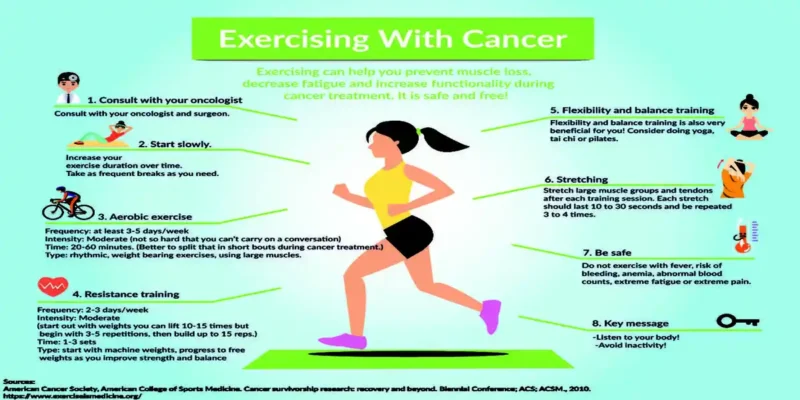[ez-toc]
Introduction
Cancer treatment can bring about physical and emotional challenges for individuals facing this journey. While exercise may not be the first thing that comes to mind, maintaining physical activity during different stages of cancer treatment can offer numerous benefits.
However, it’s essential to adapt exercise routines to each stage of treatment, taking into account the individual’s condition, energy levels, and medical advice.
In this article, we’ll explore how exercise can be tailored to different stages of cancer treatment to enhance overall well-being and quality of life.
The Importance of Exercise during Cancer Treatment
Physical activity can play a significant role in the well-being of cancer patients, offering both physical and psychological advantages:
- Enhanced Energy Levels: Regular exercise can combat fatigue and increase energy levels, which are commonly affected by cancer treatments.
- Improved Mood: Physical activity releases endorphins, which can help alleviate feelings of anxiety and depression often experienced during treatment.
- Maintained Muscle Mass: Exercise can help prevent muscle loss and maintain strength, crucial for daily functioning.
- Enhanced Cardiovascular Health: Cardiovascular exercises promote heart health and can counteract the side effects of certain treatments.
- Support for Immune System: Moderate exercise may support the immune system’s function, aiding the body’s ability to fight infections.
Adapting Exercise for Different Stages
1. Pre-Treatment Phase
Before beginning any exercise regimen, consult with a healthcare professional. During the pre-treatment phase, focus on:
- Light Aerobic Activity: Engage in gentle activities like walking, swimming, or stationary cycling to build a baseline of fitness.
- Flexibility Exercises: Incorporate stretching routines to maintain flexibility and improve joint mobility.
- Mind-Body Practices: Consider yoga or meditation to manage stress and cultivate a positive mindset.
2. Active Treatment Phase
During active cancer treatment, exercise routines should be adjusted to accommodate energy fluctuations and potential side effects:
Also Read: Managing High Cholesterol Through Exercise: Effective Strategies for a Healthier Heart
- Listen to Your Body: Be attuned to how your body responds to exercise. On days when you feel well, engage in light activities.
- Low-Impact Exercises: Opt for low-impact exercises like gentle walking, Tai Chi, or water aerobics.
- Resistance Training: Include light resistance exercises to maintain muscle strength. Start with bodyweight exercises or resistance bands.
- Stay Hydrated: It’s crucial to stay hydrated, especially if nausea or vomiting are present.
3. Post-Treatment Phase
As you transition to post-treatment, gradually increase activity levels under medical guidance:
- Slow Progression: Gradually increase exercise intensity and duration to regain strength and stamina.
- Strength Training: Incorporate resistance training to rebuild muscle mass and bone density.
- Cardiovascular Fitness: Gradually reintroduce moderate cardiovascular activities like brisk walking or cycling.
- Social Activities: Engage in group activities or join fitness classes for social interaction and motivation.
Safety and Precautions
While exercise is beneficial, there are important considerations:
- Medical Clearance: Always consult your healthcare team before starting or modifying an exercise routine.
- Individualization: Exercise routines should be tailored to your specific diagnosis, treatment, and physical condition.
- Hydration: Stay hydrated before, during, and after exercise to prevent dehydration.
- Rest Days: Incorporate rest days into your routine to allow your body to recover.
- Listen to Signals: If you experience pain, shortness of breath, or discomfort during exercise, stop and consult a healthcare professional.
Conclusion
Adapting exercise routines for different stages of cancer treatment can contribute to a better quality of life, both physically and emotionally.
With guidance from medical professionals and a gradual approach, exercise can help individuals manage symptoms, maintain strength, and enhance overall well-being.
Whether you’re in the pre-treatment, active treatment, or post-treatment phase, exercise tailored to your needs can be a powerful tool in your cancer journey, aiding recovery and improving your sense of vitality.






